Abstract
Interrelation between the CN-sensitive cytochrome path and the CN-resistant, benzohydroxamic acid (BHM)-sensitive, or n-propylgallate (nPG)-sensitive alternative path in seed respiration during germination was examined using the nondormant upper and lower seeds of Xanthium pensylvanicum Wallr. The operation of both paths was required not only for normal germination of the lower seed but also for KCN- or NaN3-induced germination of both. From the sensitivity to BHM of the germination response, it became obvious that the alternative path exerts its physiological activity as soon as it develops during the early period of water imbibition. Pretreatments with KCN and NaN3 for promoting germination, strikingly decreased only the engagement of the cytochrome path in the subsequent respiration without affecting that of the alternative path. Nevertheless, no germination occurred without the operation of the cytochrome path. This suggested that excess operation of the cytochrome path is detrimental to germination, being maximal following the BHM-sensitive phase.
The alternative and cytochrome paths operated in a proportion of 1 to 5 in a period just before the lower seeds started to germinate. However, there was little difference between the upper seeds of relatively low germination potential and the lower seeds of relatively high potential with respect to both the developmental pattern of the alternative path and the balance of the alternative and cytochrome paths. The higher germination potential of the lower seeds may be related to their high capacities for the alternative path.
Full text
PDF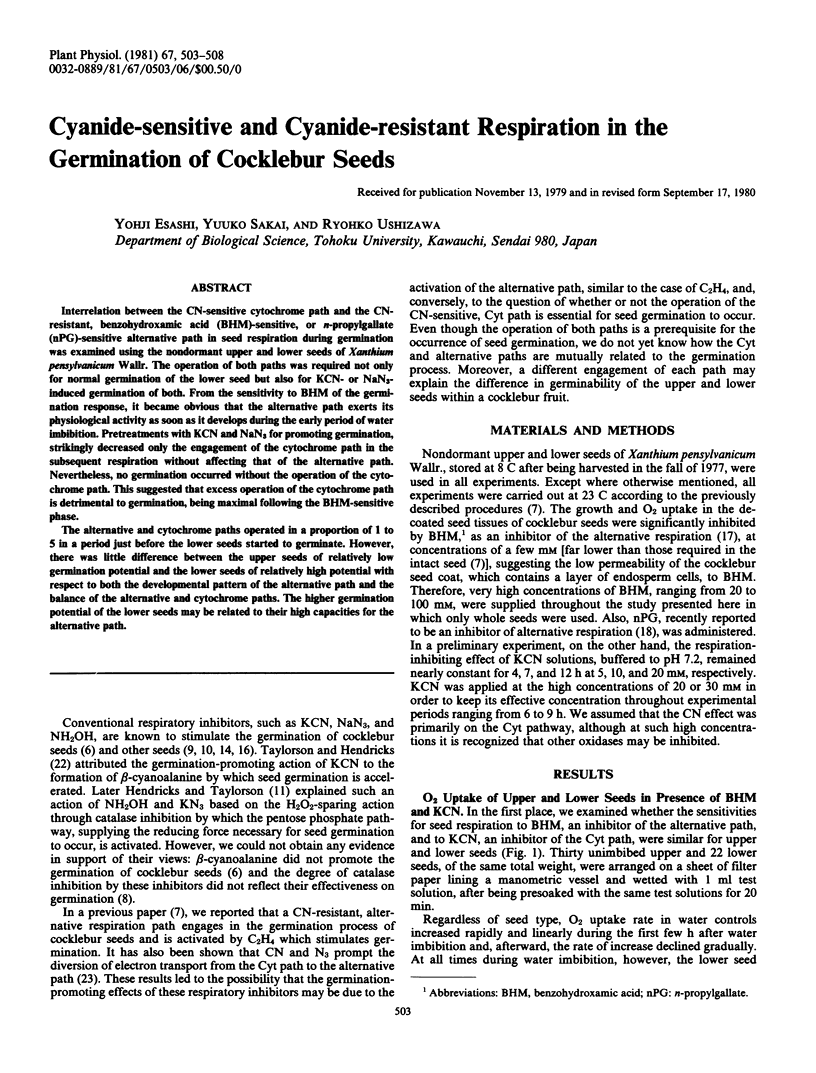
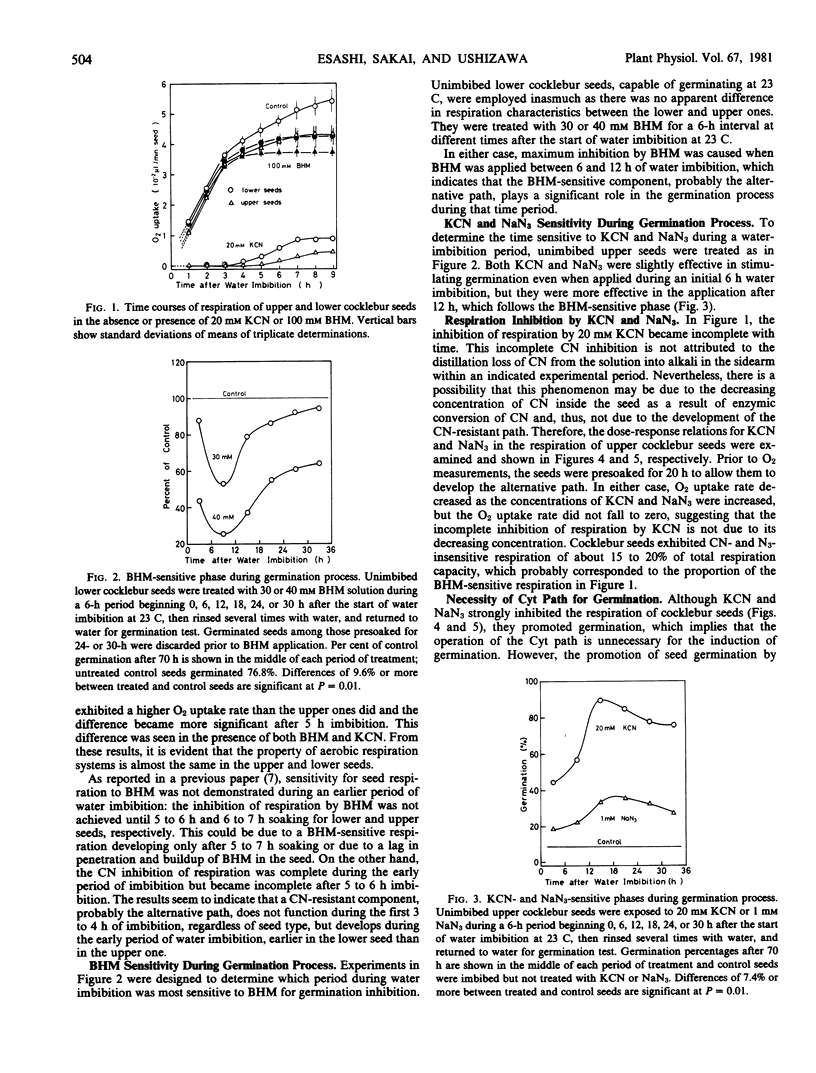
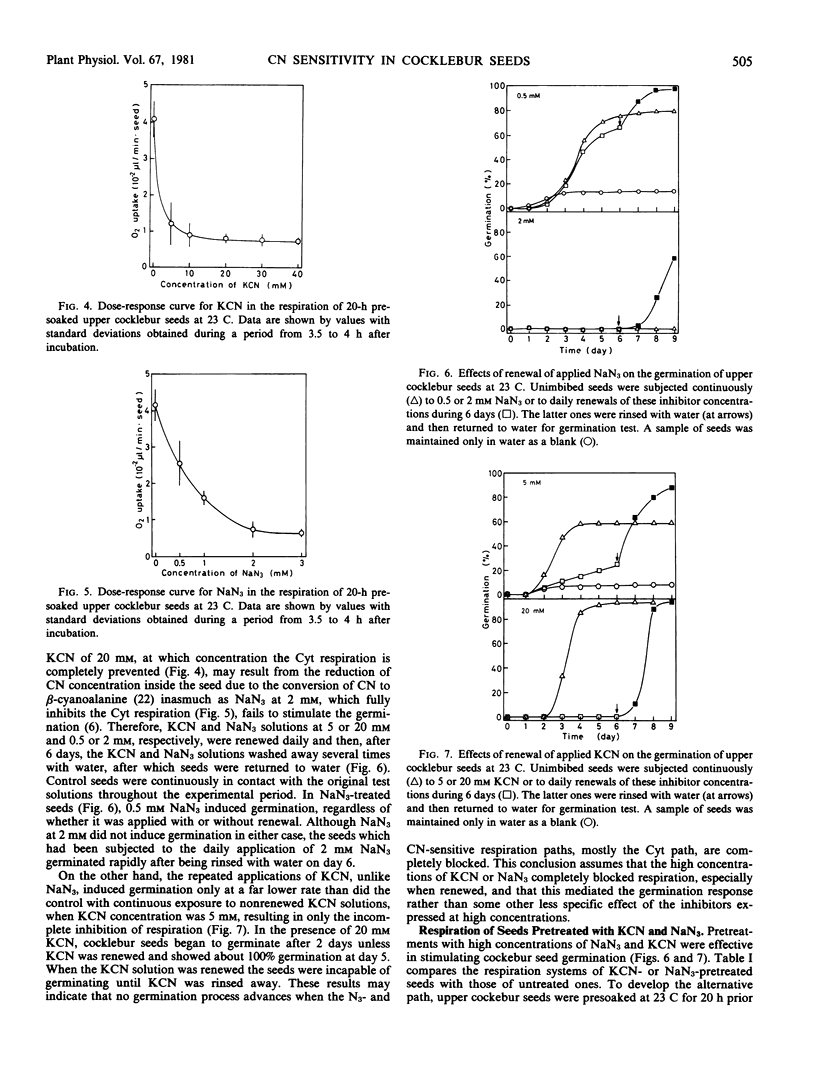
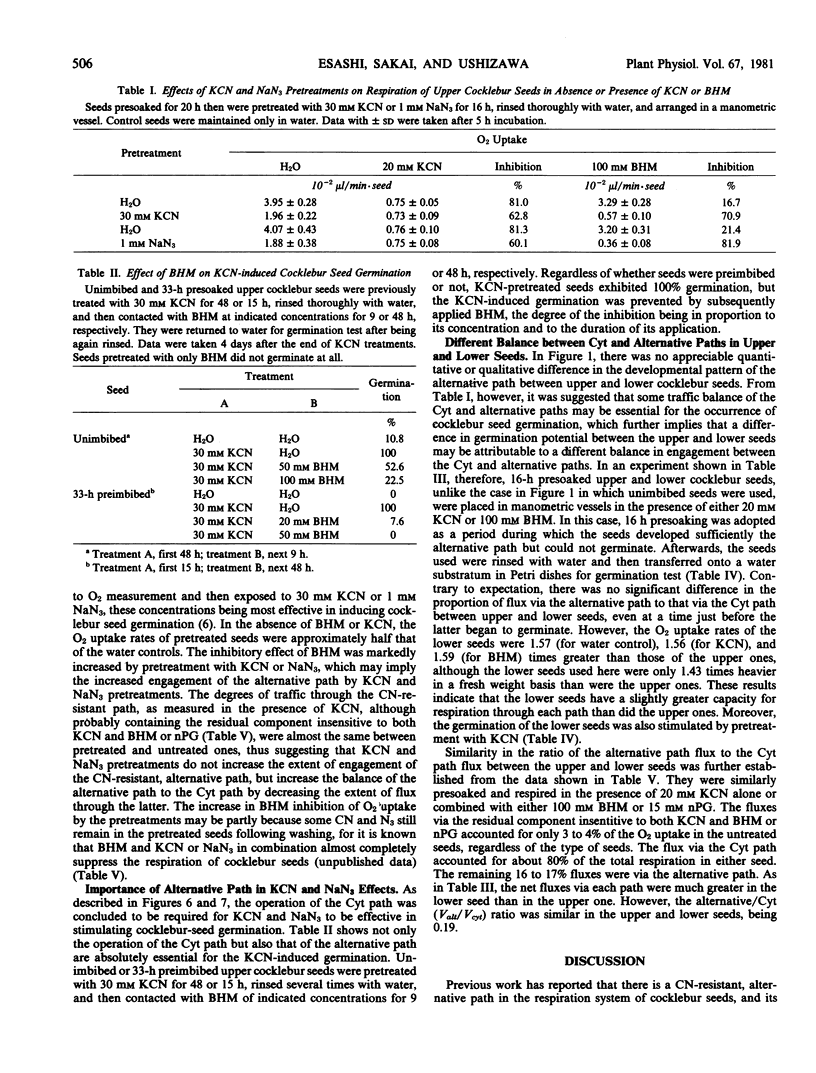
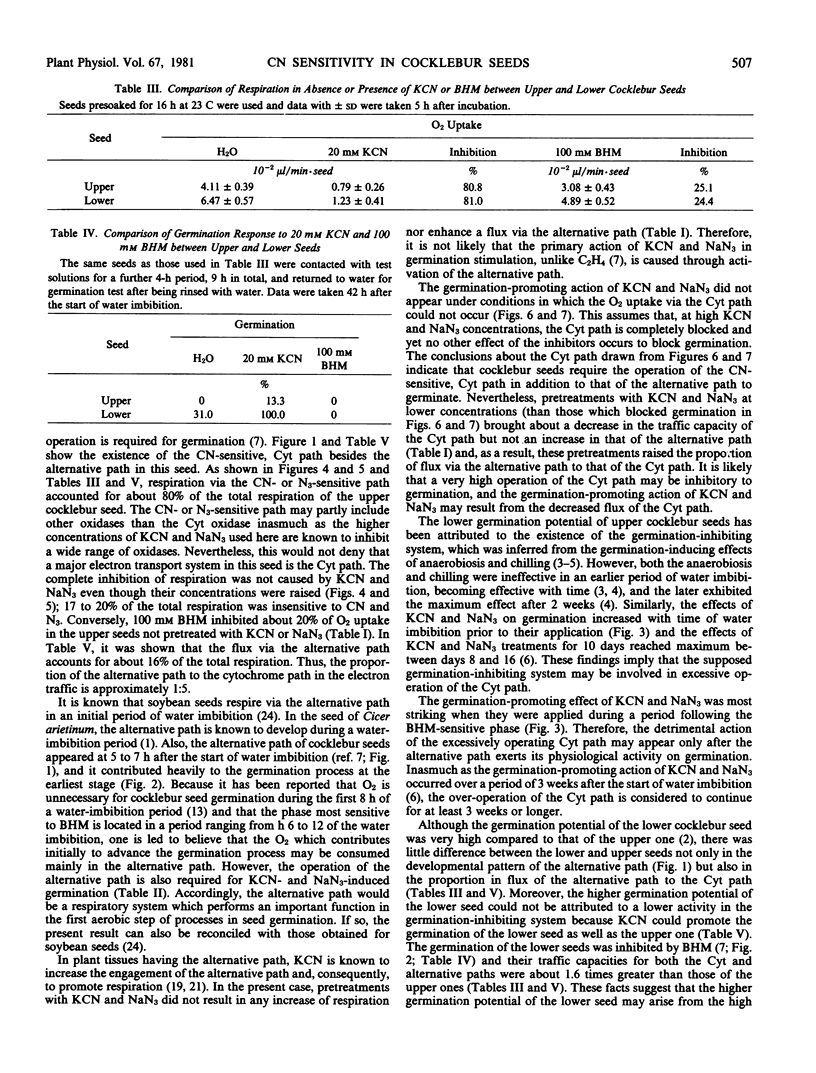
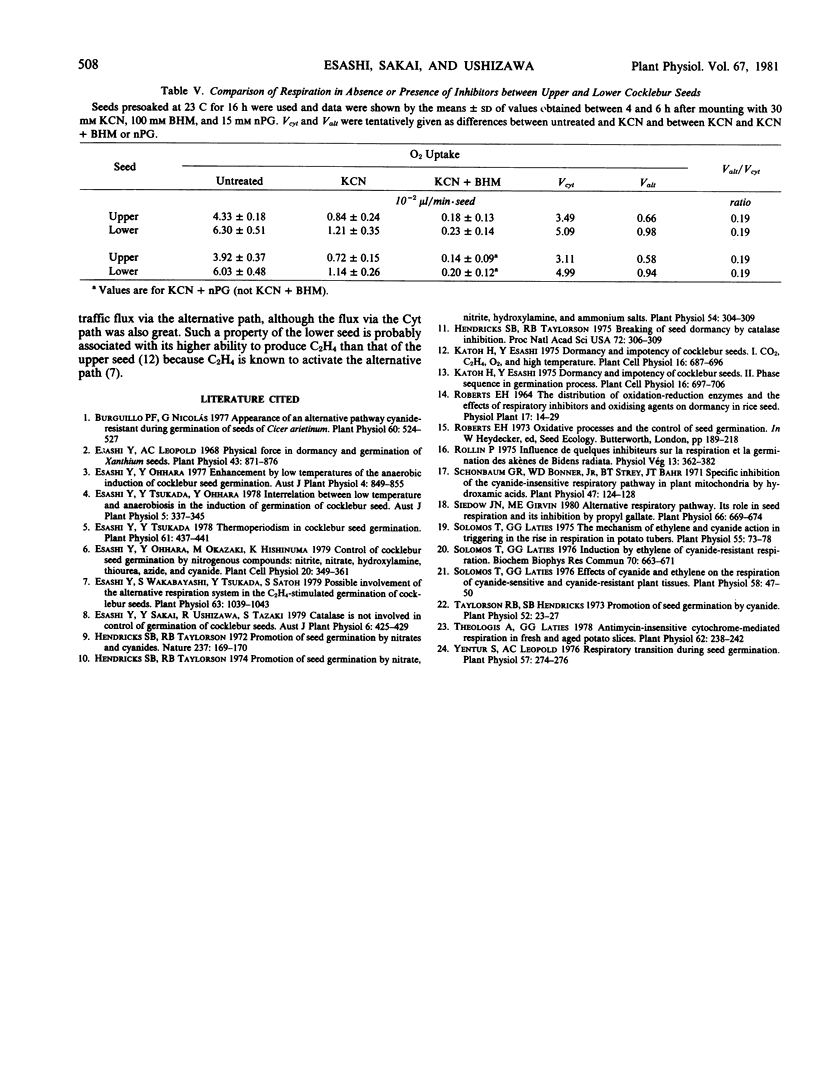
Selected References
These references are in PubMed. This may not be the complete list of references from this article.
- Burguillo P. de L., Nicolás G. Appearance of an Alternate Pathway Cyanide-resistant during Germination of Seeds of Cicer arietinum. Plant Physiol. 1977 Oct;60(4):524–527. doi: 10.1104/pp.60.4.524. [DOI] [PMC free article] [PubMed] [Google Scholar]
- Esashi Y., Leopold A. C. Physical forces in dormancy and germination of xanthium seeds. Plant Physiol. 1968 Jun;43(6):871–876. doi: 10.1104/pp.43.6.871. [DOI] [PMC free article] [PubMed] [Google Scholar]
- Esashi Y., Tsukada Y. Thermoperiodism in cocklebur seed germination. Plant Physiol. 1978 Mar;61(3):437–441. doi: 10.1104/pp.61.3.437. [DOI] [PMC free article] [PubMed] [Google Scholar]
- Esashi Y., Wakabayashi S., Tsukada Y., Satoh S. Possible Involvement of the Alternative Respiration System in the Ethylene-stimulated Germination of Cocklebur Seeds. Plant Physiol. 1979 Jun;63(6):1039–1043. doi: 10.1104/pp.63.6.1039. [DOI] [PMC free article] [PubMed] [Google Scholar]
- Hendricks S. B., Taylorson R. B. Breaking of seed dormancy by catalase inhibition. Proc Natl Acad Sci U S A. 1975 Jan;72(1):306–309. doi: 10.1073/pnas.72.1.306. [DOI] [PMC free article] [PubMed] [Google Scholar]
- Hendricks S. B., Taylorson R. B. Promotion of seed germination by nitrate, nitrite, hydroxylamine, and ammonium salts. Plant Physiol. 1974 Sep;54(3):304–309. doi: 10.1104/pp.54.3.304. [DOI] [PMC free article] [PubMed] [Google Scholar]
- Schonbaum G. R., Bonner W. D., Jr, Storey B. T., Bahr J. T. Specific inhibition of the cyanide-insensitive respiratory pathway in plant mitochondria by hydroxamic acids. Plant Physiol. 1971 Jan;47(1):124–128. doi: 10.1104/pp.47.1.124. [DOI] [PMC free article] [PubMed] [Google Scholar]
- Siedow J. N., Girvin M. E. Alternative Respiratory Pathway: ITS ROLE IN SEED RESPIRATION AND ITS INHIBITION BY PROPYL GALLATE. Plant Physiol. 1980 Apr;65(4):669–674. doi: 10.1104/pp.65.4.669. [DOI] [PMC free article] [PubMed] [Google Scholar]
- Solomos T., Laties G. G. Effects of Cyanide and Ethylene on the Respiration of Cyanide-sensitive and Cyanide-resistant Plant Tissues. Plant Physiol. 1976 Jul;58(1):47–50. doi: 10.1104/pp.58.1.47. [DOI] [PMC free article] [PubMed] [Google Scholar]
- Solomos T., Laties G. G. Induction of ethylene of cyanide-resistant respiration. Biochem Biophys Res Commun. 1976 May 17;70(2):663–671. doi: 10.1016/0006-291x(76)91098-6. [DOI] [PubMed] [Google Scholar]
- Solomos T., Laties G. G. The mechanism of ethylene and cyanide action in triggering the rise in respiration in potato tubers. Plant Physiol. 1975 Jan;55(1):73–78. doi: 10.1104/pp.55.1.73. [DOI] [PMC free article] [PubMed] [Google Scholar]
- Taylorson R. B., Hendricks S. B. Promotion of seed germination by cyanide. Plant Physiol. 1973 Jul;52(1):23–27. doi: 10.1104/pp.52.1.23. [DOI] [PMC free article] [PubMed] [Google Scholar]
- Theologis A., Laties G. G. Antimycin-insensitive Cytochrome-mediated Respiration in Fresh and Aged Potato Slices. Plant Physiol. 1978 Aug;62(2):238–242. doi: 10.1104/pp.62.2.238. [DOI] [PMC free article] [PubMed] [Google Scholar]
- Yentur S., Leopold A. C. Respiratory Transition during Seed Germination. Plant Physiol. 1976 Feb;57(2):274–276. doi: 10.1104/pp.57.2.274. [DOI] [PMC free article] [PubMed] [Google Scholar]


